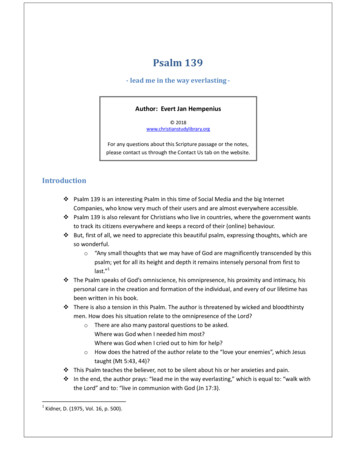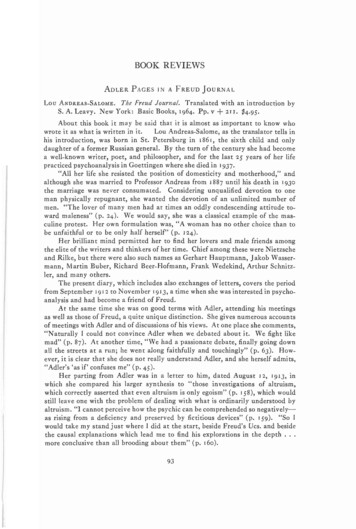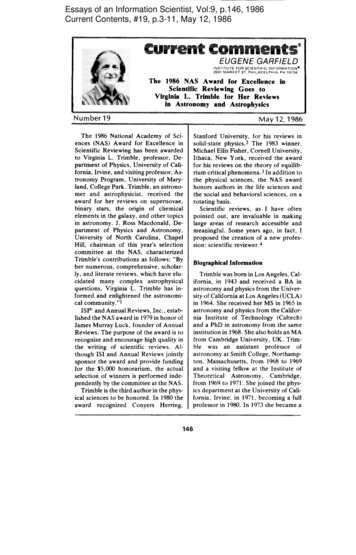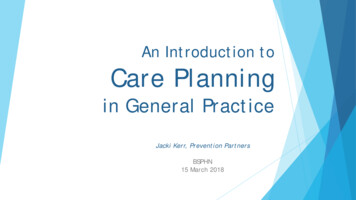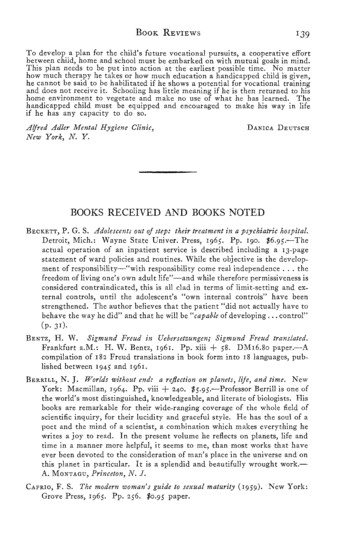
Transcription
139BOOK REVIEWSTo develop a plan for the child's future vocational pursuits, a cooperative effortbetween child, home and school must be embarked on with mutual goals in mind.This plan needs to be put into action at the earliest possible time. No matterhow much therapy he takes or how much education a handicapped child is given,he cannot be said to be habilitated if he shows a potential for vocational trainingand does not receive it. Schooling has Ii ttle meaning if he is then returned to hishome environment to vegetate and make no use of what he has learned. Thehandicapped child must be equipped and encouraged to make his way in lifeif he has any capacity to do so.Alfred Adler Mental Hygiene Clinic,DANICA DEUTSCHNew York, N. Y.BOOKS RECEIVED AND BOOKS NOTEDP. G. S. Adolescents out of step: their treatment in a psychiatric hospital.Detroit, l\t1ich.: Wayne State Univer. Press, 1965. Pp. 190. 6.95.-Theactual operation of an inpatient service is described including a 13-pagestatement of ward policies and routines. While the objective is the development of responsibility-"with responsibility come real independence . thefreedom of living one's own adult life"-and while therefore permissiveness isconsidered contraindicated, this is all clad in terms of lilnit-setting and external controls, until the adolescent's "own internal controls" have beenstrengthened. The author believes that the patient "did not actually have tobehave the way he did" and that he will be "capable of developing . control"(p. 3 1 ).BECKETT,H. W. Sigmund Freud in Uebersetzungen; Sigmund Freud translated.Frankfurt a.M.: H. W. Bentz, 1961. Pp. xiii58. DMI6.80 paper.-Acompilation of 182 Freud translations in book form into 18 languages, pu blished between 1945 and 196 1.BENTZ, BERRILL, N. J. Worlds without end: a reflection on planets, life, and time. NewYork: Macmillan, 1964. Pp. viii240. 5.95.-Professor Berrill is one ofthe vlorld's most distinguished, knowledgeable, and literate of biologists. Hisbooks are remarkable for their wide-ranging coverage of the whole field ofscientific inquiry, for their lucidity and graceful style. He has the soul of apoet and the mind of a scientist, a combination which makes everything hewrites a joy to read. In the present volume he reflects on planets, life andtime in a manner more helpful, it seems to me, than most works that haveever been devoted to the consideration of man's place in the universe and onthis planet in particular. It is a splendid and beautifully wrought work.A. MONTAGU, Princeton, N. J. CAPRIO, F. S. The modern woman's guide to sexual maturity (1959). New York:Grove Press, 19 65. Pp. 256. 0.9 5 paper.
BOOKS RECEIVED AND BOOKS NOTEDEIll N, D. (Ed.) The drug experience: first-person accounts of addicts, writers, scientists, and others (1961). New York: Grove Press, 1965. Pp.385. 0.95paper.-For the many who are interested in current research and problemsof drug prescription and addiction, but will not have firsthand experience ofdrug effects, this symposium serves an essential purpose. The accounts arewell chosen to cover a wide range, including classic as well as present-daydescriptions, and are highly readable.ELLIS, A. The case for sexual liberty. Vol. I. Tucson, Arizona: Seymour Press,J 41. 7.50, 8 1/2 X 1 T, offset, paper.-Ellis goes into great1965. Pp. vihistorical and geographical detail furnishing evidence against the "monogamous instinct." Bibliography of some 900 titles. ELLIS, A. Sex without guilt (1958). 0.75 paper.New York:Grove Press, 1965.Pp. 184.FINCHER, C. A preface to psychology. New York: Harper & Row, 1964. Pp. viii117. 2.25 paper.-This is truly a preface in that (a) it fills in a background of essentially relevant information and (b) it is at the beginningstudent's level, "to make a long but interesting story short and bearable," asthe author says in connection with his explanation of standard deviation.Finch's orientation is an insistence that empirical facts are the substance ofpsychology and that an understanding of the facts must be based on anunderstanding of the methods by which they are acquired. He deals withcharacteristics of science; historical antecedents of psychology; the experimental, clinical, and statistical approaches; present preoccupations and rolesof psychology-among other aspects, and he is fair to all. FONTES, MOTHER M. E. Existentialism and its implications for counseling. Chicago: Franciscan Herald Press, 1965. Pp. 42. 0.35 paper.-After a briefhistory and summary of existential insights among philosophers and psychotherapists, the author gives seven principles which apply these insights tocounseling: respect for the counselee's individuality; sharing the experienceof encounter; acknowledging the counselee's possibilities of becoming, andhis ability to transcend himself and his situation; encouraging the acceptanceof responsibility, and the acceptance of his limitations; helping him in thesearch for his life values.FREUD, ANNA. Psychoanalysisfor teachers and parents: introductory lectures ([953).Transl. by Barbara Low. Boston: Beacon, 1960. Pp. 119. 1.25 paper."Psychoanalysis gives us a scientific theory of the instincts, of the unconscious and of the libido" (p. 106).GROTJAHN, M. Beyond laughter: humor and the subconscious (1957). New York:McGraw-Hill, 1966. Pp. xvi285. 2.95 paper.-This book by a psychoanalyst strikes the unsympathetic reader as if it were intended to makepsychoanalysis itself the object of humor. The corks growing on cork treesin the illustrations to Munro Leaf's Ferdinand the bull are phallic symbols.The ubiquitous Kilroy drawing of World War II not only included a phallicsymbol in the form of the nose, but "spelled phonetically reads Kill-roi .the Oedipus. His face and his slogan testify publicly that the deeds of Oedi-
BOOKS RECEIVED AND BOOKS NOTEDpus can be performed." The Oedipus theme is also found in the typical WildWest story. And so it goes. All this is admitted to be unconscious in thosewho cause the laughter as well as those reacting with it. But Grotj ahn alsoadmits that "we cannot prove the unconscious" (p. viii).HARTLEY, RUTH E., & HARTLEY, E. L. (Eds.) Readings in psychology. 3rd ed.New York: Crowell,1965. Pp. x 612. 4.25 paper.-The selections areso up-to-date and significant that they will represent an excellent refreshercourse for the instructor who uses this book wi th his classes. Yet at the sametime the readings are well within the comprehension one may assume of thestudent in introductory psychology. Among the 57 selections is the paper byKilpatrick and Cantril on "Self-anchoring scaling; a measure of individuals'unique reality worlds," first published in this Journal, 1960, 16, 158-173.HARTOGS, R., & FREEMAN, Lucy. The two assassins. Nevv York: Crowell, 1965.Pp. xv 264. ' 5.95.-The authors' skillful selection of material from theWarren Commission on Oswald and Ruby is fascinating reading, and comprises about four-fifths of this book. I ts value is not, however, matched in theinterpretive sections where the full psychoanalytic view is applied. Strikingsimilarities between the two assassins do become apparent, but the dogmaticemployment of the Oedipal schema-enabled by the inseparability of sex andaggression, the interchangeability of love and hate (Ruby's mother showedher "favoritism" for him by beating him), and the reality-value of fantasy(the father Oswald never had could be hated and feared all the more)-makesindistinguishable bedfellows of the two on the authors' Procrustean couch,to the point that "Oswald committed the crime that, in his secret soul, Rubymay have wished to commit."HOLLAND, G. A. Fundamentals of psychotherapy. New York: Holt, Rinehart &Winston, 1965. Pp. xi 308. 6.95.-This is a carefully systematized, clearlywritten presentation of what psychotherapy means to the author-who isboth well grounded in psychology and the theory of psychotherapy as well asits practice. His purpose is to base psychotherapy in the principles of psychology, and he does so by treating the three general concepts of feeling,cognition, and communication, as each relates to the "conceptualizing, diagnosing, and helping with human problems" (p. ix). Holland employs theready combination of hedonism derived from Freud with elements from morerecent learning theory. The goal of therapy is thus given in terms of "morepleasurable experiences," and its function is to help the patient to takeresponsibility for, and choose freely these experiences.JACOBI, JOLANDE. Der Weg zur Individuation. Zurich: Rascher, 1965. Pp. 160.Sfr. 11.5 paper.-A serious consideration of the larger aspects of C. G.Jung's encompassing conception of individuation written by a leading exponent of J ung's theories. There is much rethinking and reformulation necessary in order to make the individuation theory accessible to other schools ofpsychology. Though this book is cast altogether within the Jungian perspective, it is a valuable contribution.-I. PROGOFF, New York, N. Y.JUNG, C. G. Civilization in transition. Trans!. by R. F. C. Hull. New York:Bollingen Foundation, Pantheon Books, 1964. Pp. xii618. 6.75.-This
BOOKS RECEIVED AND BOOK NOTEDvolume TO of Jung's collected works includes his controversial writing duringthe Nazi period. The entire series is most carefully produced, e.g., with all theparagraphs numbered through.KELLER, W. Das Se/bstwertstreben: Wesen, Formen und Schicksale. Munich:Reinhardt, 1963. Pp. 170. DM 1],00.-The author confronts the psychoanalystic concept of drives with his concept of human existence as the strivingtoward self-realization and self-perfection, which carries over into all thebasic drives. He presents convincing evidence that the striving for selfesteem is basic to man irrespective of the actual form of his life, as manifested in the greatest degree in the erroneous forms of self-realization of theneurotic. He sharply criticizes Freud without failing to appreciate his "immeasurable merits." But Adler's assertions which would be basic to theauthor's conception, are barely mentioned. I nstead, he considers his views oninhibition as supplementary to those of Schultz-Hencke. The book couldactually be regarded as a contribution to Individual Psychology.-MARGARETE KRAUSE-ABLASS, Kie/, Germany.KIELL, N. (Ed.) Psychiatry and psychology in the visual arts and aesthetics: abibliography. Madison & Milwaukee: Univer. Wisconsin Press, 1965. Pp.xiv250. 5.00.-0ver 7200 titles are presented here. These are arrangedin 22 sections and an author index, including sections on tests on aesthetics,art aptitude and projective techniques. KINSEY, A. C. et al. Sexual behavior in the human female ([953).Pocket Books, 1965. Pp. xxxii963. 1.65. New York:KORNHA USER, A. Mental health of the industrial worker: a Detroit study. NewYork: Wiley, 1965. Pp. xi354. 7.95.-Poor mental health is defined asconsisting essentially of low self-esteem and social alienation, feelings of hostility and dissatisfaction with life. The main finding is that among comparatively secure, well-paid auto workers mental health varies with the job level,with the best mental health found in the highest occupations. While ingeneral the men are moderately happy, the author finds that at all levelsthey pursue relatively narrow goals of personal success so that they lead ahumdrum existence and are not fully alive. "Without worthwhile goals (beyond the immediate and personal) life is empty and . deeply unsatisfying"(p. 288). "What would give new import and zest to their lives . is arousedmotivation to join with their fellows . to build a better world" (p. 290). KORNRICH, M. (Ed.) Underchievement. Springfield, Ill.: C. C. Thomas, 1965.Pp. xxii670' I8.50.-Fifty-one articles, most of them previously published, are presented here as a sample selected from 500 published and unpublished papers on the subject. Strangely enough the work of H. G. Goughis not included. KRIs, E. Psychoanalytic explorations in art (1952). New York: Schocken Books,1964. Pp. 384. 2.95 paper.-This is a most scholarly and fascinating book,no matter what one's stand toward psychoanalysis, with 79 illustrations. LEIBOWITZ, H. W. Visual perception. New York: Macmillan, 1965. Pp. xii177. 1.95 paper.-Leibowitz has achieved the goal of the "Critical issues
BOOKS RECEIVED AND BOOKS NOTEDin psychology" series by his authoritative, straightforward, and provocativedepicting of visual perception. He blends narrative (6o pp.) and abridgedoriginal articles (] 03 pp.) dealing with classical and contemporary, animal,and human research in 8 perceptual areas: adaptation, stability, and continuity, based upon learned constancies; innate aspects; learning; selectivityand attention; motivation; illusions as mismodificatiol1; man-machine relations; and the active contribution of the nervous system. Emphasis is on"the active role of the organism in perception." The book is clearly writtenand incorporates a generous number of examples from everyday experience aswell as from the laboratory.-M. W. PERRINE, Univer. Vermont.LONG, N. ]., MORSE, W. C., NEWMAN, RUTH G. (Eds.) Conflict in the classroom:the education of emotionally disturbed chtldren. Behnont, Cal.: Wadsworth,J965. Pp. xiSIS. 6.00. 4.S0 paper.-Here is a tremendous amount ofinformation. Beyond 100 pages of literary selections describing how it feelsto be emotionally disturbed, there are over 50 papers on providing for, working with, and learning about children with learning and/or emotional disabilities. The editors and F. Redl, who wrote the foreword, contribute athird of the papers, and indicate the organization of their greatly variedmaterial with a running commentary. In their view, most disturbed children"are having a very difficult time handling their impulsivity," and the needis to understand the child's (and the teacher's) in trapersonal problems. Aminority voice with an interpersonal emphasis is, however, also presented. LOWEN, A. Love and orgasm. New York: Macmillan, 1965. Pp·303. 6.95.This is a serious book, most readable for both the professional and lay person.It is an attempt to correlate love and sexual behavior into a holistic approachto personality. In the last analysis, however, Dr. Lowen makes this relationship quite mechanistic. His description and understanding of sexualmaturity versus sexual sophistication is very fine.-R. T. CROSS, Louis A.Weiss Memorial Hospital, Chicago, Ill.MALAMUD, D. 1., & MACHOVER, SOLOMON. Toward self-understanding: grouptechniques in self-confrontation. Springfield, Ill.: C. C. Thomas, 1965. Pp.xii269. 8.5o.-The authors, who have conducted over 100 workshops inadult education, report here on two with mental health clinic outpatientsawaiting psychotherapy. The purpose of such workshops, which havegenerally 15 weekly, two-hour sessions, is to promote self-understandingwhich will bring about positive changes in the lives of their 30-60 members,through carefully planned classroom procedures, called "experiments." Thebook's purpose to serve as a useful guide for such procedures is very wellcarried out. A full report is given of the workshop sessions, including constructive criticism of the leaders, and a follow-up of each menlber. Thereare suggestions for over 60 c'experinlents." MANDLER, JEAN M., & MANDLER, G. (Eds.) Thinking:from association to Gestalt.New York: Wiley,1964' Pp. x300. 4.95.-This is truly a "Perspectivesin psychology" book, excellently planned and executed to bring the readerthe pleasure and understanding uniquely derivable from an historical accoun t. In it one shares the rediscovery of old wisdom, and the exci temen t of
BOOKS RECEIVED AND BOOKS NOTEDpast controversies and brilliant discoveries within one's own memory. Thesophisticated choice of selections, underscored by the editorial comments,clearly brings out the course taken from the philosophic to the psychologicalconcern with thinking. While each of the 10 contributors is significant, it isa particular merit of the editors to have made the German scholars available(over 50 pages in the editors' own smooth translation), especially to have"uncovered" the work of Selz. Relevant views of other au thors are broughtinto the commentaries.McKINNEY, F. Understanding personality: cases in counseling. Boston: Houghton Mifflin, 1965. Pp. xiv338. S.so.-This book should serve well itsmain function as stated by L. Carmichael in his introduction "to help theserious student . to gain a first-hand knowledge of what people who needcounseling are like." At the end of each case are a few questions regardingoutstanding personality trends and patterns, and a listing of concepts withreferences helpful in understanding the case. The orientation is eclectic,from a client-centered base line. Nearly each of the 10 cases reported has afollow-up account from as much as twenty years after the initial consultation.This is a most welcome contrast to most cases in the literature and makes thebook particularly valuable. NOTTERMAN, J. M., & MINTZ, D. E. Dynamics of response. New York: Wiley,1965. Pp.177. 8.9S.-This is a report of research within the Skinneriantradition. The dynamics of response were the peak force exerted upon themanipulandum, duration of response, and the time integral of force. Amongthe phenomena studied were differentiation, double discrimination, extinction, and avoidance. Novel contingencies were also introduced, such as"proportional reinforcement," where reinforcement magnitude was proportional to the force expended. Discussions were lucid and restrained. Thebook is an excellent example of careful scientific work and is recommendedto students of operant behavior.-N. J. SLAMECKA, Univer. Vermont.REIFF, R., & RIESSMAN, F. The indigenous nonprofessional. Lexington, Mass.:Comm. Ment. Hlth J., Box 13, 1966. Pp.31. 1.00 paper.-The concept ofemploying people from the ranks of those who are to be helped has beenadopted by the Office of Economic Opportunity, and is being explored bythe National Institute of Mental Health, as a strategy of change in community mental health programs. This monograph provides a conceptualframework for the selection, training, and use of such nonprofessionals (ofwhom 70,000 are currently employed). It discusses the new "Expeditor"role similar in some ways to the "Ombudsman" who has been successful inSweden and is now being innovated in England.SAS, S. Der Hinkende als Symbol. Zurich: Rascher,I964' Pp. 151. Sfr. 16.50.A study of the archetypal theme of the deformed person, especially the onewho is lame, as a figure in cultural myths, religion, and art. A good exampleof the Jungian method of amplification, it ranges across many fields in thecomparative study of symbolism before presenting a psychological commentary in terms of Jung's conception of individuation. 10 illustrations.I. PROGOFF, New York, N. Y.
BOOKS RECEIVED AND BOOKS NOTEDSINGER, E. Key concepts in psychotherapy. Foreword by E. S. Tauber. NewYork: Random House, 1965. Pp. xvi 384. 6.95.-Siding with those whoconsider psychotherapy related to self-actualization and ethics, Singer, connected with the William Alanson White Institute, attempts here a clarification of the terminology of various authors. Some of the concepts treated inrespective chapters are interpretation, resistance, transference, countertransference, insight, and termination. Despite his own diverse position,the author retains Freud as standard, and the alternatives are essentiallyneo-Freudian. The Adlerian will find much that is very familiar to him, yetthe chief mention of Adler is found in a mere footnote acknowledging thatAdler was "among the first" to recognize man's potential for active cooperation as a primary tendency.STRUNK, 0., JR. Mature religion: a psychological study . New York: AbingdonPress, 1965. Pp. 160. 2.75.-A scissors-and-paste skimming through thewritings of "depth psychology" (Freud, Jung, and Fromm) and "heightpsychology" (J ames, Allport, and Frankl) for the standards of mature (read"good") religion. The utterances of the psychologists are reported as if theywere oracular. There is only one reference to Adlerian psychology, informingus that it emphasizes the "will to power." This misunderstanding was forgivable 30 years ago, perhaps, but not today.-REv. R. L. POWERS, Chicago.Studien aus dem C. G. ]ung-Institut, Zurich, XVIII. Psychotherapeutische Probleme. Mit Beitragen von G. Adler, M.-L. von Franz, H. K. Fierz, J olandeJacobi, K. Binswanger, B. Hannah. Zurich: Rascher, 1964. Pp. 206. Sfr.20.6o--A collection of essays by six leading Jungian psychotherapists, onepracticing in England, the others in Switzerland. The subjects are wideranging, including the question of meaning in psychotherapy, the magicalquality of the unconscious, the stages of life, and sexual problems. A valuablecollection of essays from the Jungian point of view.-I. PROGOFF, New York,N. Y.TOMKINS, S. S., & IZARD, C. E. (Eds.) Affect, cognition, and personality: empiricalstudies. New York: Springer, 1965. Pp. xii464. Io.oo-The book'spurpose "to accelerate the growing interest . . in the feasibili ty and significance of the empirical study of affect" (p. v.) is accomplished by presentingan adequate sampling of contemporary research, even though a cohesivesystematic position does not emerge. Of particular interest are the studiesby: Tomkins on polarities and on the psychology of commitment; Medsickon birth order, personality variables) and reaction to negative affect; Harveyon the influence of cognition of affective arousal; Leventhal and Sharp onfacial expressions as indicators of affect during childbirth; Exline and Winterson interpersonal perception and mutual glances; and Ekman on nonverbalcommunication of affect as source of information about interpersonal relations.-M. W. PERRINE, Univer. Vermont. WILLIAMS, R. H., & WIRTHS, CLAUDINE G. Lives through the years: styles of lifeand successful aging. Foreword by T. Parsons. New York: Atherton Press,1965. Pp. xiii298. 8.95-Continuing the work by Cumming and Henry,Growing old (Basic Books, 1961), the present authors refine the conception
146----BOOKS RECEIVED AND BOOKS NOTEDof a disengagement process by making it relative to the individual's style oflife. For successful aging a person should be enabled to continue his style oflife. From a thorough interview study of 168 aging Ss the authors arrive atthe optimistic conclusion that "the majority of people in the dominantAmerican cuI ture . will be found to be relati vely successful agers . thehighly unsuccessful agers constitute a small minority" (p. 211). The conceptof style of life used here, is explained by the senior author in the present issueof this Journal.B. B. (Ed.) Scientific psychology: principles and approaches. Consult.Ed. E. Nagel. New York: Basic Books, J965. 12.50. Pp. xv620.-Thevolume is "an attempt to bring about a rapprochment between scientificpsychology and the philosophy of science." I t consists of 30 original chaptersby philosophers and psychologists arranged in 3 parts (principles, systems,issues). The part on systems, by far the largest, has chapters on Pavlov,neo-Hullian behaviorism, Gestalt psychology, Individual Psychology, personalistic psychology, but also on the vagueness in psychological theroies, andchoice points in behavior research, among others. The editor has succeededin bringing many interesting papers together, including one third from countries other than the U. S. But one misses a clear organization of the volumeand any attempt at integrating the various contributions.WOLMAN, NEWS AND NOTESThe l5th Annual Meeting oj the American Society oj Adlerian Psychology willbe held in Chicago, May 28-29, [966. As in the previous year, the meeting willtake place at St. Joseph Hospital, 2900 North Lake Shore Drive. For furtherinformation write to Miss Margaret E. Goldman, executive secretary, 445 Well.ington Avenue, Chicago, Ill. 60657.The Ioth International Congress oj Individual Psychology will be held in Salzburg, Austria, September 1-4, 1966, in the Kongresshaus. For information andreservations write to Dr. Knut Baumgartel, Tuchlauben 7, A-I01O Vienna,Austria.Group Flight Arrangements have been made in connection with the SalzburgCongress for members of the American Society of Adlerian Psychology. Theflight will leave Kennedy Airport, July 28, and return there, September 7. Therate is 360.00 round trip. For further information write to Dr. Lucia Radl, 246West End Avenue, New York, N. Y. 10023.Danica Deutsch read a paper, "Family Therapy and Family Life Style," athe Twenty-third Conference of the American Group Psychotherapy Association,'hiladelphia, January 29, 1966.
bibliography. Madison & Milwaukee: Univer. Wisconsin Press, 1965. Pp. xiv 250. 5.00.-0ver7200 titles are presented here. These are arranged in 22 sections and an author index, including sections on tests on aesthetics, art aptitude and projective techniques. KINSEY, A. C. et al. Sexual
